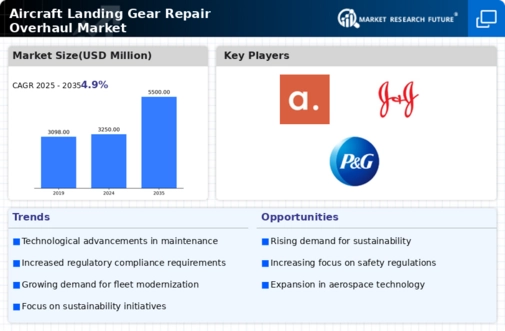Aging Aircraft Fleet
The aging fleet of aircraft in the United States is a significant driver for the aircraft landing-gear-repair-overhaul market. Many commercial and cargo airlines operate older aircraft, which require more frequent maintenance and repair services. According to the FAA, a substantial portion of the U.S. fleet is over 20 years old, leading to increased wear and tear on critical components such as landing gear. This situation creates a heightened demand for repair and overhaul services to ensure operational safety and efficiency. As airlines seek to extend the lifespan of their aircraft, the aircraft landing-gear-repair-overhaul market is poised to see sustained growth, driven by the necessity of maintaining aging fleets.
Increased Air Traffic Demand
The aircraft landing-gear-repair-overhaul market is experiencing growth due to the rising demand for air travel in the United States. As airlines expand their fleets to accommodate more passengers, the need for maintenance and repair services, particularly for landing gear, becomes critical. The Federal Aviation Administration (FAA) has reported a steady increase in air traffic, with projections indicating a growth rate of approximately 3.5% annually. This surge in air traffic necessitates regular overhauls and repairs to ensure safety and compliance with aviation standards. Consequently, the aircraft landing-gear-repair-overhaul market is likely to benefit from this trend, as airlines prioritize the reliability and performance of their aircraft to meet passenger expectations.
Growing Focus on Cost Efficiency
Cost efficiency is becoming a paramount concern for airlines operating in a competitive market. The aircraft landing-gear-repair-overhaul market is influenced by the need for airlines to manage operational costs effectively. As fuel prices fluctuate and economic pressures mount, airlines are seeking ways to optimize their maintenance expenditures. This trend has led to a greater emphasis on preventive maintenance and timely overhauls to avoid costly unscheduled repairs. By investing in the aircraft landing-gear-repair-overhaul market, airlines can enhance the reliability of their fleets while controlling costs. This focus on cost efficiency is likely to drive innovation and competition within the market, as MRO providers strive to offer more value-driven services.
Regulatory Pressure for Safety Standards
Regulatory bodies in the United States impose stringent safety standards that directly impact the aircraft landing-gear-repair-overhaul market. The FAA mandates regular inspections and maintenance protocols to ensure that landing gear systems meet safety requirements. Compliance with these regulations is non-negotiable for airlines and MRO providers, driving demand for repair and overhaul services. The increasing focus on safety and risk management in aviation further amplifies this need. As regulations evolve and become more rigorous, the aircraft landing-gear-repair-overhaul market must adapt to meet these challenges, potentially leading to increased investment in maintenance capabilities and technologies.
Technological Integration in Maintenance
The integration of advanced technologies in maintenance practices is transforming the aircraft landing-gear-repair-overhaul market. Innovations such as predictive maintenance, data analytics, and automation are enhancing the efficiency and effectiveness of repair processes. Airlines and maintenance, repair, and overhaul (MRO) providers are increasingly adopting these technologies to reduce downtime and improve safety outcomes. For instance, predictive maintenance can identify potential issues before they escalate, allowing for timely interventions. This trend not only optimizes operational costs but also aligns with the industry's focus on safety and reliability. As technology continues to evolve, the aircraft landing-gear-repair-overhaul market is likely to experience a shift towards more sophisticated and efficient repair methodologies.

















Leave a Comment